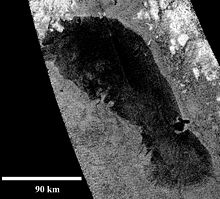Ontario Lacus
Ontario Lacus is a methane / ethane - Lake near the south pole of Saturn's moon Titan . Ontario Lacus was confirmed as a liquid hydrocarbon lake by infrared observations from the Cassini spacecraft on July 31, 2008 in the journal Nature . With an area of approx. 15,000 km², Ontario Lacus is roughly the same size as Schleswig-Holstein or Styria , and is therefore somewhat smaller than its earthly origin, Lake Ontario in North America .
On January 12, 2010, the Cassini probe performed a higher-resolution radar scan of the Ontario Lacus, revealing numerous remarkable characteristics. The northern bank is characterized by approx. 1 km high hills and flooded river valleys. A straight, undulating coastline similar to that of southwest Lake Michigan can be observed in the northeast area. Lines running parallel to the current bank may have been formed over long periods of time by low waves, which in turn are presumably caused by westerly or southwest winds. The south-eastern coast shows a rounded bay that protrudes far into the lake.
The central part of the western coast has the first observed and well-defined river delta on Titan. Similar to the Rhone delta in the French Camargue , judging by its morphology, it is a wave-dominated delta in which liquid hydrocarbons coming from higher areas change their river channel on their way to the lake and have thus created at least two peninsulas. Further examples of such channel changes or wave-dominated deltas can be found on earth at the southern end of Lake Albert in Africa between Uganda and the Democratic Republic of the Congo and as remnants of the former inland sea Mega-Chad in Chad .
Compared to earthly waters of similar extent, Ontario Lacus appears to be strikingly shallow and smooth. Radar scans in July 2009 and January 2010 showed an average depth of only 0.4 to 3.2 m with a maximum depth of 2.9 to 7.4 m. This would result in an estimated volume of only 7 to 50 km³, less than one-thirtieth of that of Earth's Lake Ontario. Any waves on Ontario Lacus at the time of measurement are also at most 1 mm high, which indicates either the complete absence of wind and / or a viscous , i.e. H. the viscous composition of the liquid hydrocarbons in the lake.
According to the latest research, the level of the liquid in the Ontario Lacus, as in the Etosha pan, changes with the level of the liquid in the ground.
See also
Web links
- Ontario Lacus in the Gazetteer of Planetary Nomenclature of the IAU (WGPSN) / USGS
- NASA / JPL videos of new knowledge about the Ontario Lacus
- Artistic representations (English)
- DLR: Saturn's moon Titan - streams and lakes made of liquid hydrocarbons
- Space probe explores the Titan Sea
Individual evidence
- ↑ NASA Confirms Liquid Lake On Saturn Moon , NASA. July 30, 2007.
- ↑ http://photojournal.jpl.nasa.gov/catalog/PIA13172
- ↑ Mike Wall: Saturn Moon's 'Lake Ontario': Shallow and Virtually Wave-free . In: Space.Com web site . December 17, 2010. Retrieved December 19, 2010.
- ↑ Ralph-Mirko Richter: Titansee Ontario Lacus resembles the Etosha pan, in Raumfahrer.net, Date: April 21, 2012, Accessed: April 21, 2012

